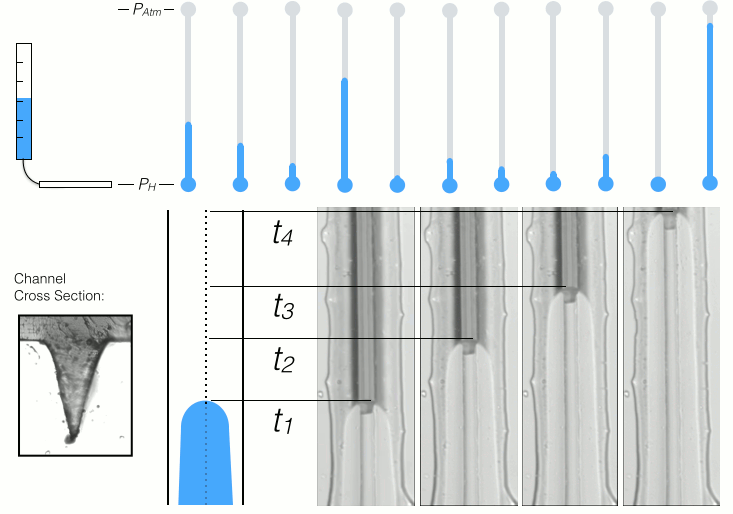Reports: DNI952923-DNI9: Direct Investigations of Enhanced Oil Recovery by Sequential Waterflooding with Microscale Models
John Oakey, PhD, University of Wyoming
Enhanced oil recovery techniques are becoming and increasingly important component of the petroleum production portfolio, particularly from declining reservoirs. Waterflooding has been practiced for almost a century, and now accounts for over one half of global oil production, yet much is unknown about the detailed mechanisms responsible for waterflood efficiency. This is particularly true for situation in which low salinity brines are used, with mixed and unpredictable success. Despite its vast potential, the underlying physical mechanisms of low salinity waterflooding remain unclear. To address this gap, we have developed microfluidic tools that more accurately simulate the morphology and chemistry of reservoir rock than traditional “micromodels”. We have introduced new microfluidic fabrication techniques to produce these tools, which have been utilized to investigate hypotheses regarding interfacial and transport phenomena of low salinity waterflooding. We have hypothesized that the ionic strength of the brine used in low salinity floods can mediate the interfacial elasticity of the oil, this exacerbating or suppressing the dispersion of continuous oil phases into emulsions. The overarching goals of this project have therefore been twofold: 1) To develop novel fabrication techniques for the creation of micromodels with arbitrary cross sections. This capability would allow the production of micromodels that are more accurately representative of the confining geometry of reservoir rock. 2) Use these new platforms to isolate individual experimental phenomena, allowing investigation of single-variable effects in otherwise highly complex multiphase systems. These goals build upon one another to develop platforms that can be used to deconstruct the phenomena that contribute to highly unpredictable multi-scale behavior. The results of the second year of our project are discussed below.
Goal 1: Fabrication Technique Development
Varying the cross-sectional geometry of microfluidic channels can dramatically alter fluid flow behavior, but most fabrication techniques are planar and therefore incapable of easily generating variations in depth. In the first project year, we developed femtosecond pulsed laser ablation-based fabrication to create microchannels with highly controlled triangular cross sectional geometry. We also developed a technique by which glass channels could be replicated within elastomers and polymers or bonded directly to a second glass substrate to create a sealed device. Triangular cross sections are of particular interest because they more accurately represent the pore-throat occurring in sandstones and other sedimentary reservoirs.
Figure 1. Cross sectional shape produces dramatically different wetting conditions in response to constant capillary pressures.
Figure 1 depicts three geometries that can be used in micromodels: capillary tubes of round cross section, square channels created by photolithography and triangular channels that we have introduced, fabricated by femtosecond pulsed laser direct-writing. It is clear that the wetting of each cross sectional shape, in response to a fixed capillary pressure, produces dramatically different interfacial curvature and wetted perimeter values. Building upon the successful development of fabrication processes, we have begun to evaluate multiphase flow within triangular networks. Figure 2 illustrates experiments that were performed to evaluate critical capillary pressures within straight triangular channels. These experiments represent the first experimental validation of the Mayer and Stowe-Princen (MS-P) theory of drainage for channels of triangular cross section. Successful description of breakthrough drainage pressures by the MS-P theory now allows us to construct networks of triangular channels in order to investigate multiphase displacements within complex two-dimensional porous media representations.
Figure 2. Triangular channels of different cross sectional area and perimeter were fabricated in glass, replicated in polydimethylsiloxane and used to validate the MS-P theory of multiphase drainage for arbitrary shaped capillaries.
Goal 2: Evaluating Waterflooding Mechanisms
In the first year of the project, we designed microscale hydrodynamic focusing networks to evaluate the effects of brine salinity upon emulsion drop snap off, the event by which oil is emulsified during pore filling or drainage. In year 2, we have extended this work to examine the effects of brine chemistry, in particular ion charge and size. Trends have emerged indicating that brine chemistry can subtly regulate charge and therefore composition in the oil at the two-phase interface. While this mechanism continues to be examined, we have begun the process of linking micromodel studies to our observations that brine chemistry regulates interfacial elasticity. Our on-going studies are focused on experimental pore filling and drainage experiments to examine deviations from Raliegh-Plateau descriptions of snap off and MS-P descriptions of capillary pressure and saturation, respectively. This work is a continuation of the vision for this DNI award: that advanced microfabrication methods could be translated to micromodel construction, which in turn would enable the elucidation of previously intractable mechanisms that govern multiphase flow behavior in porous media.













